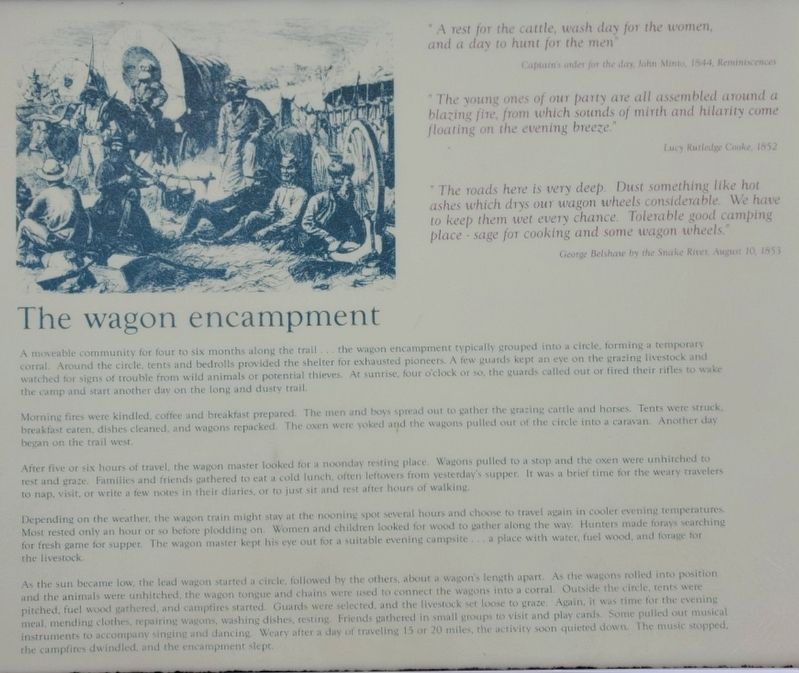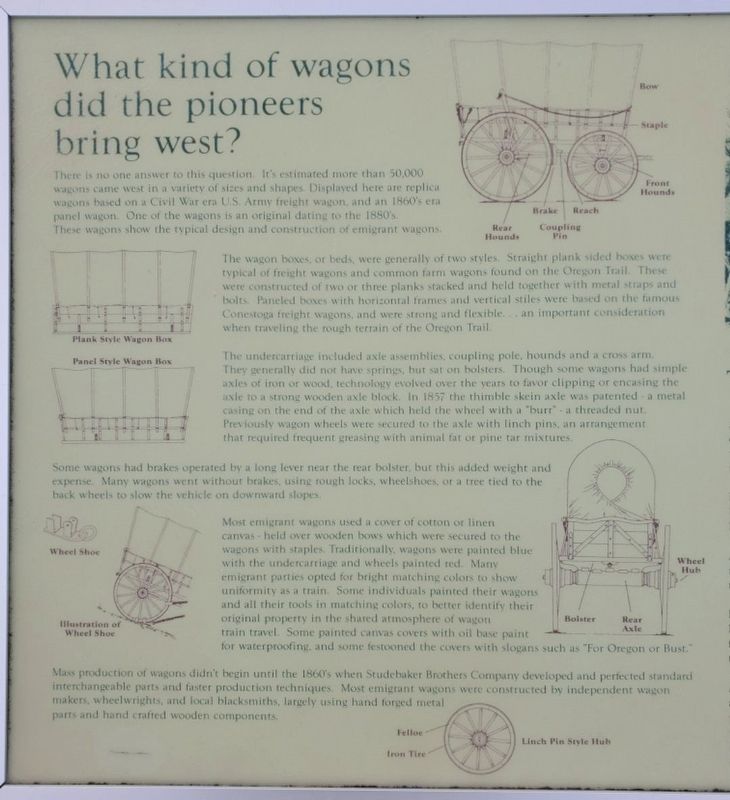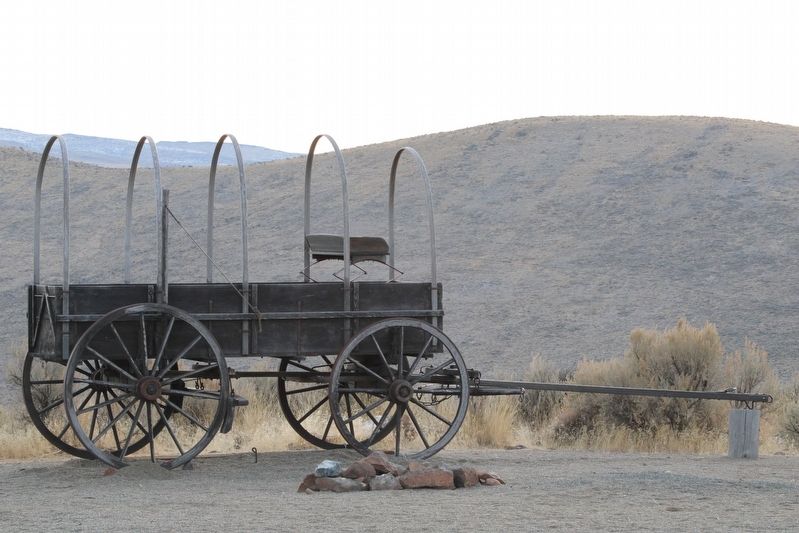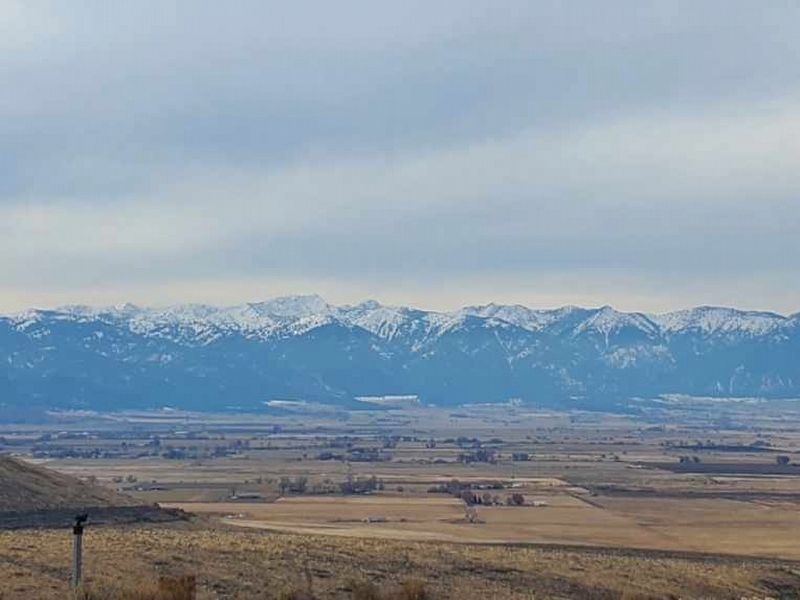Baker City in Baker County, Oregon — The American West (Northwest)
The Wagon Encampment
A moveable community for four to six months along the trail… the wagon encampment typically grouped into a circle, forming a temporary corral. Around the circle, tents and bedrolls provided the shelter for exhausted pioneers. A few guards kept an eye on the grazing livestock and watched for signs of trouble from wild animals or potential thieves. At sunrise, four o’ clock or so, the guards called out or fired their rifles to wake the camp and start another day on the long and dusty trail.
Morning fires were kindled, coffee and breakfast prepared. The men and boys spread out to gather the grazing cattle and horses. Tents were struck, breakfast eaten, dishes cleaned, and wagons repacked. The oxen were yoked and the wagons pulled out of the circle into a caravan. Another day began on the trail west.
Depending on the weather, the wagon train might stay at the nooning spot several hours and choose to travel again in cooler evening temperatures. Most rested only an hour or so before plodding on. Women and children looked for wood to gather along the way. Hunters made forays searching for fresh game for supper. The wagon master kept an eye out for a suitable evening campsite….a place with water, fuel wood, and forage for the livestock.
As the sun became low, the leas wagon started a circle, followed by the others, about a wagon length apart. As the wagons rolled into position and the animals were unhitched, the wagon tongue and chains were used to connect the wagons into a corral. Outside the circle, tents were pitched, fuel wood gathered, and campfires started. Guards were selected, and livestock set loose to graze. Again, it was time for the evening meal, mending clothes, repairing wagons, washing dishes, resting. Friends gathered in small groups to visit and play cards. Some pulled out musical instruments to accompany singing and dancing. Wearing after a day of traveling 15 to 20 miles, the activity soon quieted down. The music stopped, the campfires dwindled, and the encampment slept.
What kind of wagons did the pioneers bring west?
There is no answer to this question. It’s estimated more than 50,000 wagons came west in a variety of sizes and shapes. Displayed here are replica wagons based on a Civil War era U.S. Army freight wagon, and an 1860’s era panel wagon. One of the wagons is an original dating to the 1880’s. These wagons show the typical design and construction of emigrant wagons.
The wagon boxes, or beds, were generally of two styles. Straight plank sided boxes were typical of freight wagons and common farm wagons found on the Oregon Trail. These were constructed of two or three planks stacked and held together with metal straps and bolts. Panel boxes with horizontal frames and vertical stiles were based on the famous Conestoga freight wagons and were strong and flexible…an important consideration when travelling the rough terrain of the Oregon Trail.
The undercarriage included axle assemblies, coupling pole, hounds and a cross arm. They generally did not have springs, but sat on bolsters. Though some wagons had simple axles of iron or wood, technology evolved over the years to favor clipping or encasing the axle to a strong wooden axle block. In 1857 the thimble skein axle was patented – a metal casing on the end of the axle which held the wheel with a “burr” – a threaded nut. Previously wagon wheels were secured to the axle with linch pins, and arrangement that required frequent greasing with animal fat or pine tar mixtures.
Some wagons had brakes operated by a long lever near the rear bolster, but this added weight and expense. Many wagons went without brakes, using rough locks, wheelshoes, or a tree tried to the back wheels to slow the vehicle on downward slopes.
Most emigrant wagons used a cover of cotton or linen canvas – held over wooden bows which were secured to the wagons with staples. Traditionally, wagons were painted blue with the undercarriage and wheels pained red. Many emigrant parties opted for bright matching colors to show uniformity as a train. Some individuals painted their wagons and all their tools in matching colors, to better identify their original property in the shared atmosphere of wagon train travel. Some painted canvas covers with oil base paint for waterproofing, and some festooned the covers with slogans such as “For Oregon or Bust.”
Mass production of wagons didn’t begin until the 1860’s when Studebaker Brothers Company developed and perfected standard interchangeable parts and faster production techniques. Most emigrant wagons were constructed by independent wagon makers, wheelwrights, and local blacksmiths, largely using hand forged metal parts and hand crafted wooden components.
Topics and series. This historical marker is listed in these topic lists: Exploration • Roads & Vehicles • Settlements & Settlers. In addition, it is included in the Oregon Trail series list.
Location. 44° 48.801′ N, 117° 43.743′ W. Marker is in Baker City, Oregon, in Baker County. The marker is mounted to a metal stand outside the National Historic Oregon Trail Interpretive Center. Touch for map. Marker is at or near this postal address: 22267 OR-86, Baker City OR 97814, United States of America. Touch for directions.
Other nearby markers. At least 8 other markers are within 5 miles of this marker, measured as the crow flies. Ruts of the Oregon Trail (approx. 0.4 miles away); The Lure of Gold (approx. 0.4 miles away); Oregon Trail Memorial (approx. ¾ mile away); The Lone Tree of the Oregon Trail (approx. 1.2 miles away); Chinese Shrine (approx. 4.4 miles away); Baker City Chinese History (approx. 4.4 miles away); Baker (approx. 4.6 miles away); The Oregon Trail (approx. 4.6 miles away). Touch for a list and map of all markers in Baker City.
Also see . . . National Historic Oregon Trail Interpretive Center. Bureau of Land management website entry:
"Using life-size displays, films and live theater presentations, this Center tells the story of Oregon Trail pioneers, explorers, miners and settlers of the frontier west. The 500 acre site includes remnants of the historic Flagstaff Gold Mine, actual ruts carved by pioneer wagons, and magnificent vistas of the historic trail route." (Submitted on June 3, 2022, by Joseph Alvarado of Livermore, California.)
Credits. This page was last revised on June 13, 2022. It was originally submitted on June 3, 2022, by Joseph Alvarado of Livermore, California. This page has been viewed 223 times since then and 35 times this year. Photos: 1, 2, 3, 4. submitted on June 3, 2022, by Joseph Alvarado of Livermore, California. • Syd Whittle was the editor who published this page.
Editor’s want-list for this marker. Wide area view of the marker and its surroundings. • Can you help?



